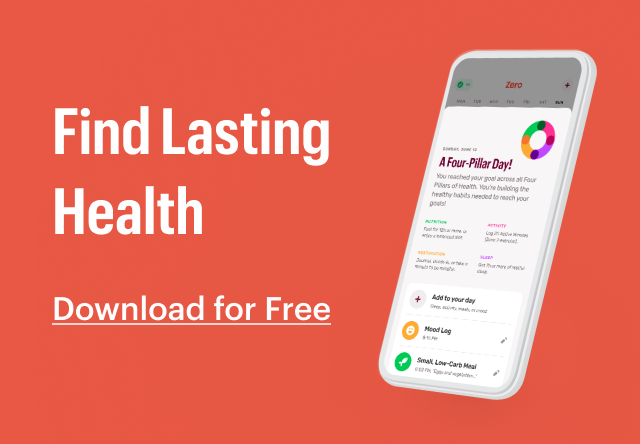Valentine’s Day is almost upon us, but instead of diving into a heart-shaped box of chocolates (maybe later), we’re digging into some health science on the symbolic organ of the hour—your heart!
If your heart’s about to be overflowing with love, you’d better make sure it’s up for the challenge. So what exactly makes a healthy heart? Or, maybe a better question, what makes a heart unhealthy? Heart disease has a number of contributing factors like age, gender, and genetics that we can’t control. But factors like lifestyle and nutrition (including your fasting practice!) also play a big part, and those are things you can adjust to keep your heart happier. Eating behavior can influence lots of risk factors for cardiovascular disease (CVD) from blood lipids and blood pressure to inflammation and body weight.

Blood Lipids
So how do you know if you’re at risk for cardiovascular disease? Lab tests for blood lipids should give you a pretty good idea. Ideally, low density lipoproteins (LDL)—aka “bad cholesterol”—will be low, along with total cholesterol and triglycerides. Conversely, high density lipoproteins (HDL)—aka “good cholesterol”—should be high.
Great news for fasters: observational studies and controlled trials have shown positive improvements in blood lipids in the context of fasting.
In a large observational study, prolonged hypocaloric fasting (~200-250 kcal per day) ranging from 5 to 20 days showed a decrease in triglycerides and total cholesterol. Researchers observed a more significant reduction in these markers with longer fasts.
Alternate day fasting (ADF), in which someone consumes 25% of estimated energy needs on alternating days, has demonstrated increases in HDL-C (good cholesterol) and LDL particle size, as well as reductions in TG, TC, and LDL-C.
In another study with normal weight and overweight subjects, 12 weeks of ADF showed a reduction in triglycerides and LDL cholesterol plus an increase in LDL particle size (a positive shift). Some of these ADF studies controlled for calories as well, making it less clear if the lipid improvements were from fasting or healthier diet, but in a different experiment with obese individuals, both high fat and low fat ADF protocols showed improvement in lipid profiles. After 7 weeks of an isocaloric ADF protocol, total cholesterol, LDL cholesterol and triglyceride levels were significantly reduced. HDL cholesterol levels were unchanged. This study helped remove the bias of a low-fat diet and showed an improvement in CVD risk more closely associated with fasting.
High Blood Pressure
High blood pressure, also known as hypertension (HTN), occurs when blood pressure readings are above the “normal” range, at 130/80 mmHg or higher. HTN is another risk factor for cardiovascular disease, heart attack, and stroke. When blood pressure is elevated over a prolonged period of time, the pressure on blood vessels increases, which could damage and ultimately rupture their interior walls. Maintaining normal blood pressure is a key pillar of cardiovascular health
While there’s limited evidence that fasting alone has long-term impacts on blood pressure, fasting paired with an improved diet does seem to have lasting effects. In one trial, subjects saw significant blood pressure reductions following a water-only fast with a whole-foods, minimally-processed diet implemented immediately afterwards (Hint for all your #Fastbreakers!)
In other observational studies, prolonged hypocaloric fasting (~200-250 kcal) ranging from 5 to 20 days demonstrated a significant decrease in both systolic and diastolic blood pressure readings. In this case, the decrease may be related to physiologic changes that occur during a fast such as higher levels of brain-derived neurotrophic factor (BDNF), increased sodium excretion from the kidneys, and enhanced receptor sensitivity to insulin. However, in this study, once the fasting period ended, blood pressure levels returned to normal. All this suggests that the post-fast diet may be critical to maintaining the blood pressure benefits accrued during a fast.
Inflammation
Atherosclerosis is the number one cause of vascular disease in the world, and it leads to multiple cardiac issues including ischemic heart disease, peripheral artery disease, heart attacks, and stroke. Sounds serious, right? So what exactly is this scary, seven-syllable word? Atherosclerosis happens when the blood vessels that carry oxygen and nutrients from your heart to the other parts of your body become thicker than normal. They even stiffen up. It causes even more issues when LDL particles, plaque, and inflammatory components in the arterial blood vessels accumulate, leading to narrowing of the arteries. Reducing inflammation overall can help reduce the risk of serious heart disease from artherosclerosis. Some research shows that certain types of fasting can help reduce certain types proinflammatory markers associated with heart disease like homocysteine, CRP, and IL6. In one study with normal and overweight individuals, a 12 week ADF protocol reduced CRP levels. In another, a fasting mimicking diet (FMD) demonstrated reduce CRP levels to the normal range in those with elevated levels prior to 3 cycles of the FMD.
Body Weight
Excess weight and obesity are pretty good predictors of cardiovascular disease, so if you fall into the obese category for your weight, shedding some pounds and getting into the normal range for BMI (18.5-24.9) will help decrease your risk of heart disease. Fasting can be a great tool to assist with weight loss. Check out our blog on “The Physiology of Fasting” to see how a prolonged fast can impact your hormones and ability to burn fat.
To sum it up…
Fasting has promising effects on reducing the risk of cardiovascular disease. Risk factors such as dyslipidemia, hypertension, inflammation, and obesity have all been shown to improve with various types of fasting protocols. Fasting, coupled with exercise and a healthy diet can help keep that heart pumping strong for many more years to come! So show your heart some love today and every day.
- Zero Live #4: 3 Ways to Boost Fat Burning - March 28, 2024
- Zero Live #3: Nutrition, Fast Breakers, and Fasting - March 11, 2024
- Zero Live #2: Metabolism, Insulin, and Fat Burning - February 29, 2024





